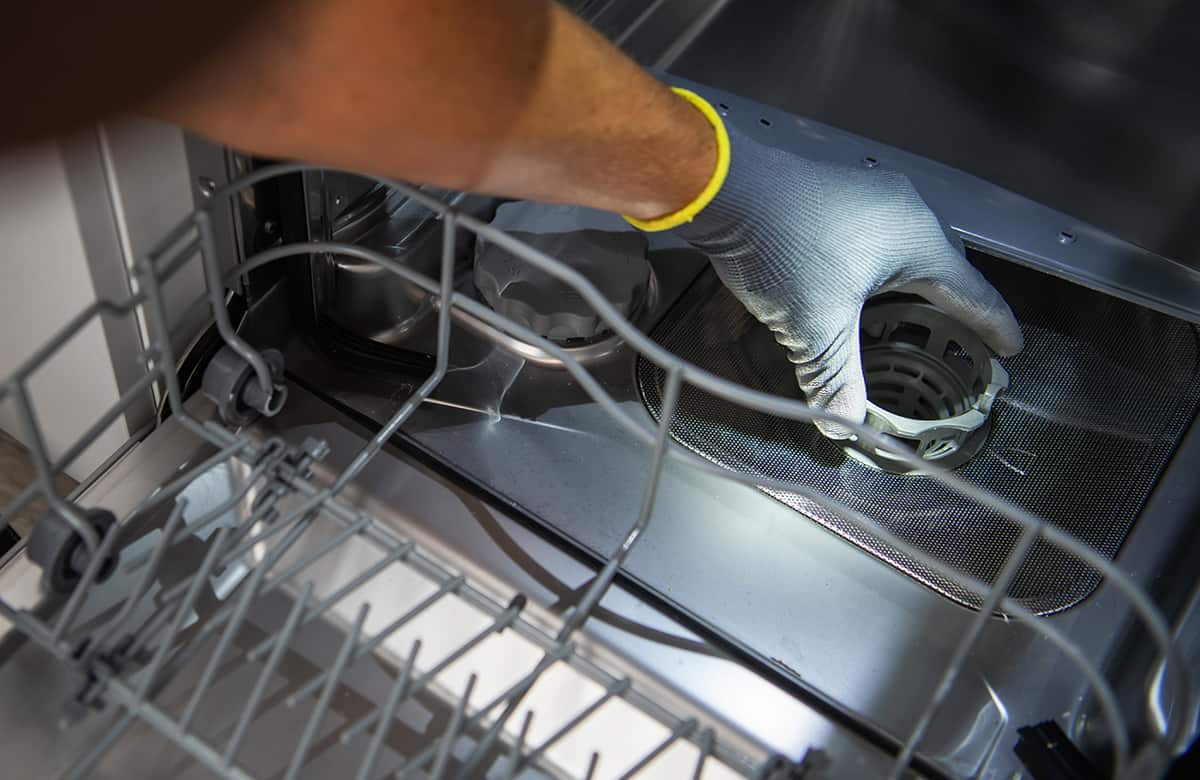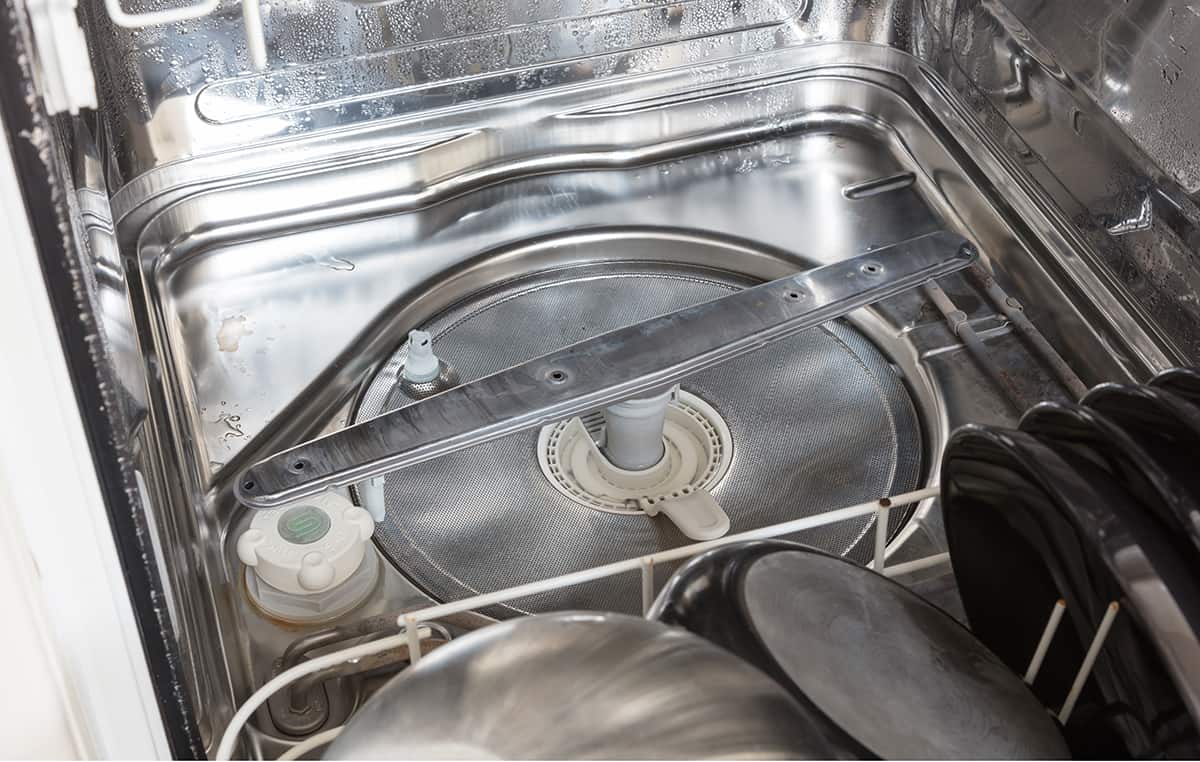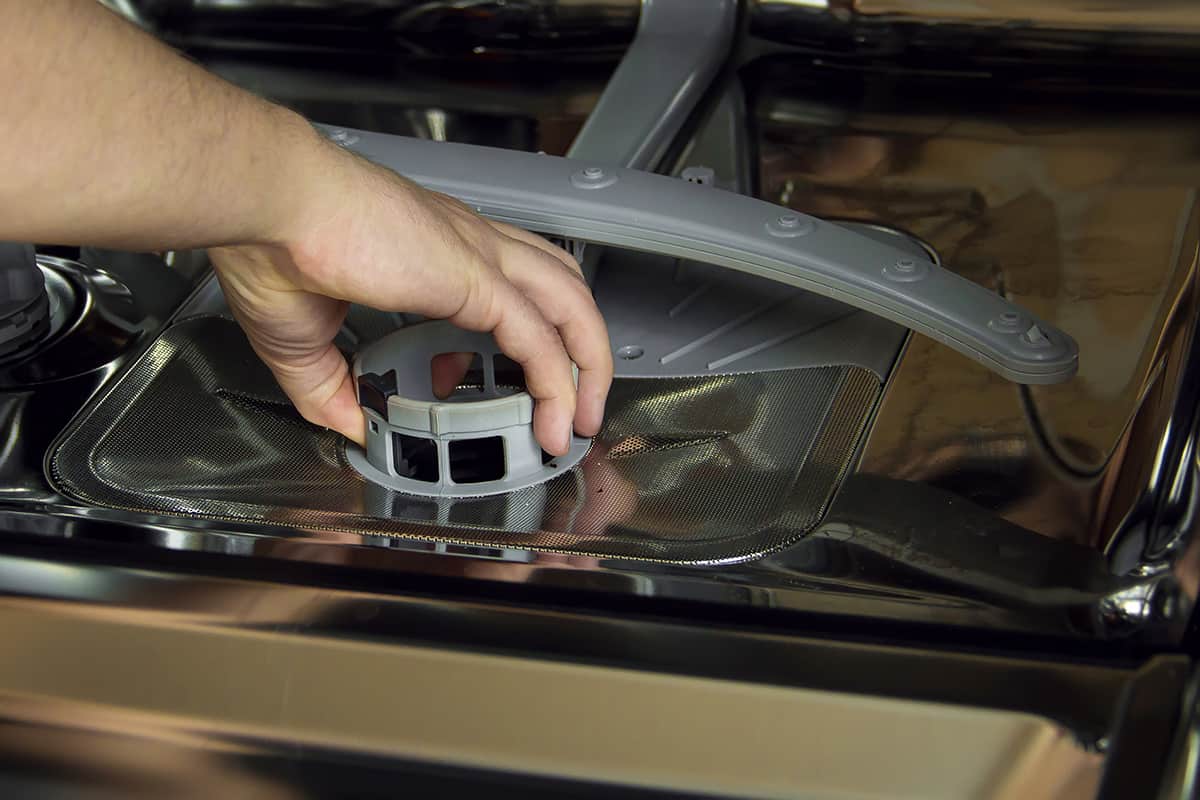So, here’s something many new dishwasher owners don’t know about. Did you know that you are supposed to clean your dishwasher’s filter? If you notice water pooling at the bottom of your GE dishwasher’s tub, there’s a good chance that the filter is clogged.
The filter assembly in a GE dishwasher contains two components: the fine filter and the ultra-fine filter. To clean your GE dishwasher’s filter, you will need to:
- Remove the bottom dishrack
- Twist the fine filter counterclockwise and pull it out
- Remove the fine filter
- Wash both filters in soapy water with a sponge or scrub brush
- Replace the filter parts in the dishwasher in reverse order
In this guide, I’ll explain what can happen when a dishwasher filter becomes clogged, how to clean the filter assembly, and how to deep-clean your dishwasher.
What Does a Dishwasher Filter Do?
If you take a look at the bottom of the dishwasher tub, you’ll find a cylindrical object underneath the sprayer arm. That object is the dishwasher’s filter assembly.
In most GE dishwashers, the filter assembly consists of a fine-mesh filter and a fine-filter body. Both of these filters work in tandem to capture solid particles that make their way to the bottom of the tub and attempt to go down the drain line.
With the filter in place, old food remnants could get into the drain line, which can eventually cause a blockage. To fix the problem, you would have to use a powerful drain cleaner or even possibly snake the drain.
What Happens When the Filter Gets Clogged?

The dishwasher’s filter may become clogged over time and after dozens of wash cycles. A few noteworthy things will happen when water cannot pass through the filter screens.
Standing water
One of the most obvious signs that your dishwasher filter is clogged is that water can’t pass through the mesh screens. This can make it impossible for your dishwasher to thoroughly dry your dishes since there is so much more moisture. Here’s our guide to help you clear standing water problems with your dishwasher.
Buildup of bacteria
When water can’t flow through the filters and down the drain line, you also have to worry about a buildup of bacteria. The microscopic organisms will thrive in an overly moist environment, and they will eventually cause your dishwasher to stink. When this happens, you will have to deep-clean your dishwasher to get rid of the lingering bacteria and odors. Stick around, and I’ll explain how to deep-clean your dishwasher.
Dishwasher won’t start
Perhaps the most concerning symptom of a clogged dishwasher filter is that the machine will not start. Although this problem can be associated with a wide range of problems, including a faulty thermal fuse or drive motor, so pinpointing the source of the problem can be difficult. However, one of the first things you should check is for blockages in the filter.
How to Clean GE Dishwasher Filter
The filter assemblies in GE dishwashers are similar to those in other dishwasher brands. One of the main differentiating features is that GE dishwasher filters have a large fine-mesh filter as opposed to a cylindrical assembly with multiple filters. However, the appearance of the filter assembly may vary between GE dishwashers.
I will describe the process of how to clean a GE dishwasher filter. This process applies to most GE dishwashers and also other brands. Before beginning, make sure there is no power running through your dishwasher. Either unplug it from the wall outlet or shut off the circuit breaker to your dishwasher.
1. Remove the bottom dishrack
To gain access to the bottom of the tub and the filter assembly, you will first have to remove the bottom dish rack. Alternatively, you can pull the dishrack all the way out. Just make sure your dishwasher is empty—otherwise, the water from the filter assembly may drip onto the dishes on the bottom rack.
2. Twist the ultra-fine filter counterclockwise until and pull it out
Before removing the fine filter, you first have to detach the ultra-fine filter from the dishwasher’s tub. Depending on the model, you will only have to do a quarter-turn before it releases from the rest of the filter assembly. Now, carefully transfer the ultra-fine filter to your kitchen sink.
3. Remove the fine filter
With the ultra-fine filter removed, we can safely detach the main filter body containing the fine filter. Tug on it gently until the wide gray base releases from the dishwasher’s tub. Again, transfer this filter component to your kitchen sink.
4. Wash both filter parts in soapy water with a sponge or scrub brush
Ideally, you should dunk the filter assembly components into a basin of soapy water and let it sit for 5 to 10 minutes. The water will slowly cause the solid particles to detach from the mesh screens slowly. Now, use the rough side of a sponge or a scrub brush and gently scrub away all of the solid bits of debris on the screen. Lastly, give them a final rinse in running water.
5. Replace the filter parts in the dishwasher in reverse order
Now that your dishwasher filters are completely clean, you can place them back into the dishwasher tub. First, put the filter body with the fine-mesh filter into the tub, then insert the ultra-fine filter into the filter body. Reattach the bottom dishrack and close the dishwasher door. Restore power to the dishwasher before running a test cycle to see whether or not water flows through the filters’ mesh screens.
How to Deep-Clean Your Dishwasher

If you cleaned your dishwasher’s filter after it was flooded with stagnant water, you should make sure to clean the dishwasher’s tub to get rid of the lingering bacteria and odors. Here’s how you do it:
- Unload the dishwasher. What we are going to do is introduce a vinegar solution to the inner walls of the dishwasher. While vinegar can be safe to consume, it can leave a nose-wrinkling scent that you don’t want on your cookware, dishes, and cutlery.
- Mix a 1:1 solution of vinegar and water and spray it on the walls, ceiling, and floor of the dishwasher tub. A mixture of vinegar and water makes for an excellent homemade cleaning spray. Best of all, it doesn’t introduce harmful chemicals to the dishwasher’s stainless-steel tub, so there’s virtually no risk of it corroding. Spray the vinegar solution all over the inside of your dishwasher and let it sit for 5 minutes.
- Rinse the inside of the dishwasher. You can either run your kitchen sink’s spray arm to your dishwasher, or you can fill a bucket with water and carefully throw the water into your dishwasher. The goal is to get rid of as much of the vinegar solution from the tub as possible.
- Place a bowl of vinegar on the dishwasher tub and run a rinse cycle. The previous steps should have thoroughly cleaned your dishwasher. However, if you want to go the extra mile, you can place a bowl or tall container filled with 1 cup of vinegar in the center of your dishwasher. Running a rinse cycle will force the dishwasher spray arms to blast the vinegar and spray it all over the tub. Run an additional rinse cycle (without vinegar this time) to rinse the vinegar away.
And just like that, the entire inside of your dishwasher should be clean of leftover debris, bacteria, and odors. Feel free to repeat this procedure depending on the severity of your dishwasher’s stinkiness.






